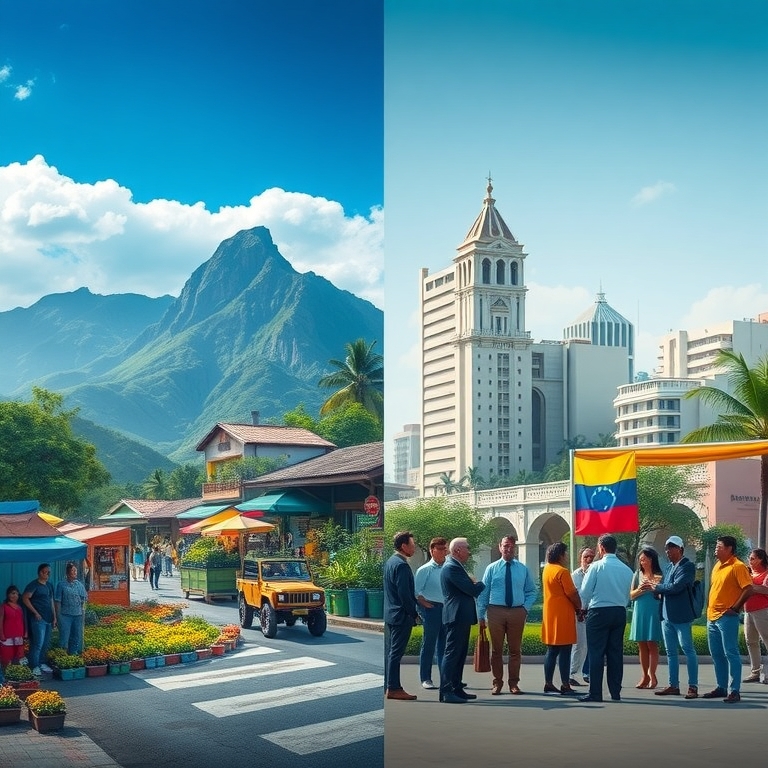In the heart of South America, two neighboring countries—Peru and Venezuela—present a fascinating tableau of contrasts, each grappling with its own set of unique challenges while simultaneously offering distinct opportunities for progress. Though separated by a mere border, the two nations have embarked on divergent paths shaped by their historical, political, and economic contexts. Understanding these complexities is essential for businesses, policymakers, and investors looking to navigate the region’s intricate landscape.
Peru, once considered a beacon of economic stability in the region, has experienced significant growth over the last two decades, driven largely by its rich natural resources, particularly in mining and agriculture. The nation boasts a wealth of minerals, including copper, gold, and silver, which have attracted foreign investment and bolstered its export economy. However, the very foundations of this growth are now under scrutiny as political instability looms large. Frequent changes in leadership, coupled with corruption scandals, have eroded public trust and hindered long-term planning. The recent political turmoil, marked by the impeachment of presidents and social unrest, has led to a fragmented political landscape, affecting decision-making processes and creating an unpredictable environment for businesses. Yet, amidst these challenges lies an opportunity for reform and renewal. The Peruvian government is working to stabilize its political climate and implement policies aimed at enhancing transparency and fostering a more inclusive economy. For investors, this presents the chance to engage with a country in transition, where strategic partnerships could yield significant rewards as stability returns.
On the other side of the spectrum, Venezuela stands as a poignant example of how mismanagement and authoritarianism can derail a nation’s potential. Once one of the wealthiest countries in Latin America, Venezuela is now grappling with a profound humanitarian crisis exacerbated by economic collapse, hyperinflation, and severe shortages of basic necessities. The oil-rich nation has witnessed its economy shrink dramatically, with millions of citizens fleeing in search of better opportunities abroad. In this context, Venezuela presents a challenging environment for businesses, characterized by a fragmented economy and a lack of reliable infrastructure. However, the resilience of the Venezuelan people and the potential for rebuilding should not be overlooked. As international sanctions begin to ease and efforts to stabilize the economy take shape, there are glimmers of hope. The transition towards a more open market could pave the way for foreign investment, particularly in sectors such as energy, agriculture, and telecommunications. Companies willing to navigate the complexities of the local landscape may find themselves well-positioned to capitalize on emerging opportunities in a country desperate for recovery.
Both nations share common threads in their pursuit of reform and economic revitalization, yet their approaches differ significantly. In Peru, the focus is on leveraging its natural resources while addressing governance issues, aiming to create a more equitable distribution of wealth and opportunities. The recent commitment to sustainability and responsible mining practices underscores the nation’s awareness of global trends and the importance of environmental stewardship. This shift not only appeals to socially conscious investors but also aligns with international efforts to combat climate change, placing Peru in a favorable position to attract foreign companies seeking to invest in sustainable practices.
Conversely, Venezuela’s path to recovery hinges on political stabilization and the re-establishment of trust between the government and its citizens. The international community has a role to play in facilitating dialogue and supporting democratic processes, which could unlock the country’s vast potential. With its oil reserves, Venezuela remains one of the largest suppliers of crude oil, and as the global energy landscape evolves, the country could reclaim its position as a key player in the market. The challenge lies in rebuilding the necessary infrastructure, re-establishing production capabilities, and fostering an environment conducive to investment. For businesses, this means engaging with local stakeholders, understanding the intricacies of the political environment, and being prepared to adapt to a rapidly changing context.
Moreover, regional cooperation presents another avenue for progress. As both nations confront common challenges such as migration, regional security, and economic recovery, collaboration could yield mutual benefits. Initiatives aimed at fostering trade relations and cross-border partnerships may not only help stabilize the economies of Peru and Venezuela but also contribute to a more integrated and resilient South American market. By leveraging their respective strengths—Peru’s agricultural and mineral wealth and Venezuela’s energy resources—the two countries could create a more balanced economic ecosystem that benefits both their populations and foreign investors.
In conclusion, the juxtaposition of Peru and Venezuela highlights the complex interplay between challenges and opportunities in the South American landscape. While Peru grapples with political instability amidst its economic growth, Venezuela faces a daunting task of recovery from a profound crisis. Yet, both nations are at pivotal moments in their histories, with the potential for transformative change on the horizon. For businesses and investors, understanding these dynamics is crucial in developing strategies that not only account for risks but also capitalize on opportunities for growth and collaboration. As the region evolves, the ability to navigate these complexities will be key to unlocking the potential that both Peru and Venezuela have to offer.



